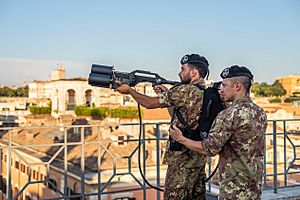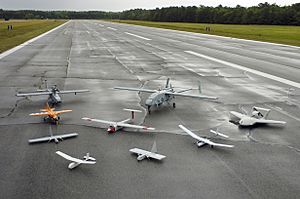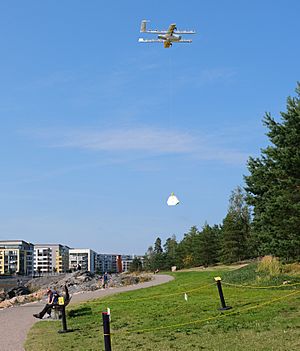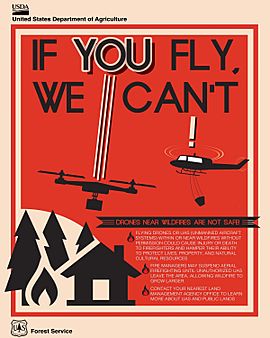Unmanned aerial vehicle facts for kids
An unmanned aerial vehicle (UAV), often called a drone, is an aircraft that flies without a pilot on board. Think of it as a flying robot!
Drones can have a computer inside that helps them handle things like wind and changes in air pressure. Some are even programmed to fly to a specific place. But usually, people on the ground control them using radios, especially for important decisions.
Large drones are mostly used by the military. They can be used for reconnaissance, which means checking out an area. Some drones are even used as targets for practice shooting. A few can carry weapons for combat. But drones also have many other uses, like helping firefighters or taking amazing photos.
Drones come in all sorts of sizes. Their wings can be as small as a few centimeters or as wide as 60 metres (200 ft), which is the size of a regular airplane!
What Drones Are Used For
Drones have many uses for everyday people, businesses, and even the military.
Military Uses
Many countries use drones for military purposes. As of 2020, seventeen countries had drones that could carry weapons. Over 100 countries use drones for other military jobs.
Drones are great for secret missions because they are hard to spot and difficult to shoot down. They are used for looking around (reconnaissance), attacking, clearing mines, and even for target practice.
Civilian Uses
Taking Photos and Videos
Drones are perfect for taking pictures and videos from high up in the sky. Filmmakers and photographers use them a lot. Drones can reach places that are dangerous, far away, or hard to get to.
Helping the Environment and Farming
Drones are very useful for watching over nature. They can help with:
- Mapping out land.
- Watching natural places like forests and rivers.
- Helping farmers grow more food with less effort. For example, they can spread fertilizers or pesticides exactly where needed.
Drones also help find and fight wildfires. They can even survey wildlife, like counting birds' nests or looking for animal burrows.
Law Enforcement
Police forces use drones for many tasks. This includes finding missing people (search and rescue) and watching how traffic moves.
Safety and Security Concerns
Problems Drones Can Cause
Annoyance and Danger
Drones can sometimes cause problems in the sky. They might accidentally hit other aircraft or distract pilots. In 2017, a drone hit an airplane in Canada. In 2018, a drone hit a hot air balloon in the United States.
Sometimes, drones flying too close to big airports have caused flights to be stopped. For example, in December 2018, drones caused a lot of trouble at Gatwick Airport in the UK.
Flying drones near wildfires is also very dangerous. It can stop firefighters from doing their job. In the US, flying a drone near a wildfire can lead to a big fine.
Security Risks
Drones have been used to drop illegal items into prisons. This shows how they can be used for bad purposes.
Attacks
Drones could be loaded with dangerous things and flown into important places.
How to Stop Bad Drone Use
Counter-Drone Systems

Because drones can be used for bad things, new technologies are being made to stop them. These are called "counter unmanned air systems" (C-UAS). Special cameras and computer programs can find and track drones. Once a drone is found, it can be stopped using missiles, lasers, or by blocking its radio signals.
Rules for Drones
Governments around the world are creating rules to make sure drones fly safely in our skies. These rules help to manage all the drones flying around.
Images for kids
-
An unmanned aerial vehicle launching a missile.
-
A Maasai person seeing a drone for the first time in 2018.
-
Winston Churchill and others watching a de Havilland Queen Bee target drone launch in 1941.
See also
 In Spanish: Vehículo aéreo no tripulado para niños
In Spanish: Vehículo aéreo no tripulado para niños
















